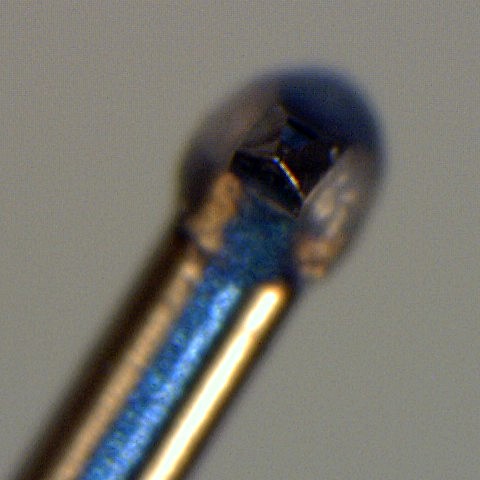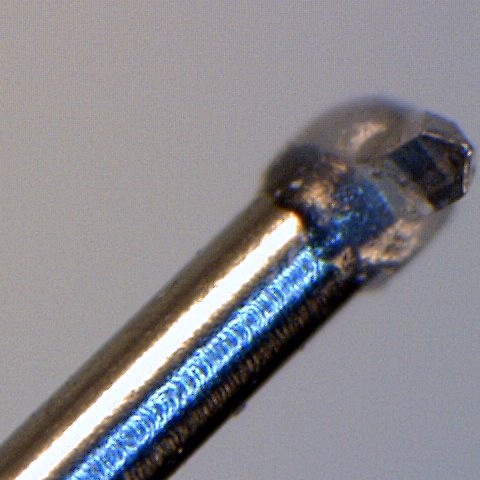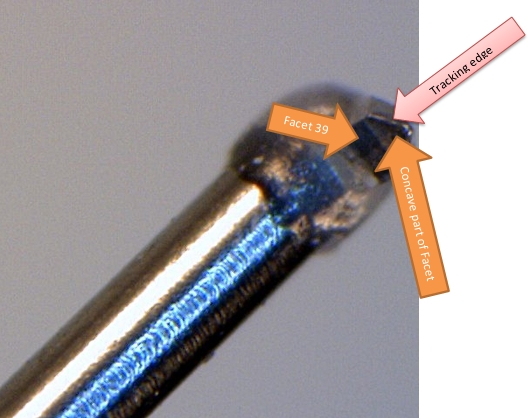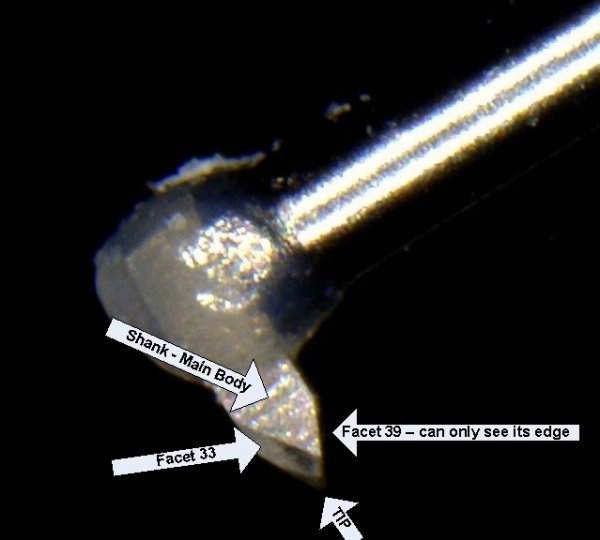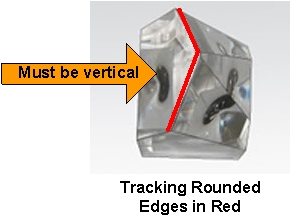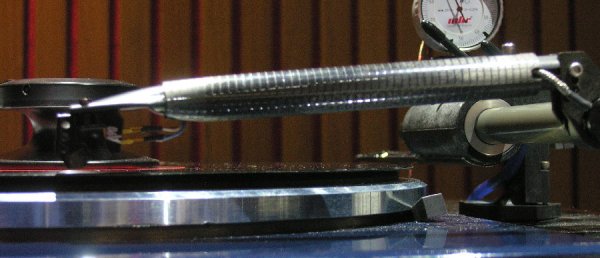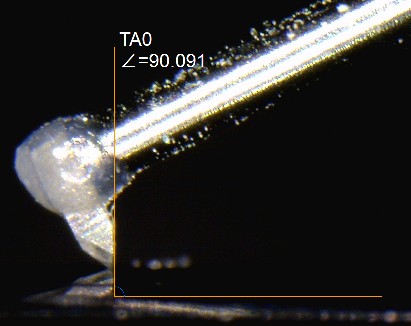I don't see much difference between these pictures and what we have been discussing in that other thread some time ago. The only difference I think I see is what I believe looks like a concave part of Facet 39 in the triangle formed by the tracking edges. Here's what I mean:
The orange arrows point to Facet 39 that must be vertical for 0 SRA. The pink arrow points to one of the tracking edges. Compare both to the last picture from vinylengine:
View attachment 3427
Here's again another annotated picture of your stylus profile from the other thread, to aid in the analysis
View attachment 3426
The vinylengine Gyger depiction
View attachment 3424
A few more observations: Facet 39 in the first picture extends beyond the blackened part where I placed the orange arrow - the black part is obviously the general contact area which is affected by heat - see second picture for verification. The actual contact area remains the two tracking edges as we have discussed before, as also prescribed by the Gyger patent. I am not sure what purpose the alleged concave part of Facet 39 serves, but perhaps it's a scoop for dirt??? Or perhaps it's not concave and I am being misled by the reflections...
If you look at my picture #2 you'll see that concave (or at least angled) area.
My concern is based on the view of the 'edge' showing a full reflection at the angle I was positioned. That suggests that perhaps the groove contact 'edge' is following a different angle than that of the leading face of the shank. If it was formed by the junction of the concave section and the main shank, the angle could conceivably be steeper than the shank view would suggest, requiring the arm to be lowered in the rear (and become more parallel to the record) to agree. Keep in mind that the part that is really 'in' the groove is only the very tip. All the mass we see above that (which is the majority) is practically irrelevant depending on exactly how the tip is angled.
So if you have done everything right, I am not sure why you can't get the A90 to work right... I really don't think we are misinterpreting anything here... Therefore I have a few questions:
- What do you mean exactly when you say you can't get to track well, and especially by "it can't maintain contact with the groove walls" - how does this mistracking manifest itself?
- Are you still within the recommended tracking range, after SRA adjustment? As I've said before, I strongly believe we must maintain this relationship
- I assume the A90 is properly aligned before these adjustments?
- Have you calculated the arm/cartridge resonant frequency? Basically, how does the cart's compliance map to your arms' effective mass? Mine is 9.25Hz (10.5g arm effective mass, 8g for the cart, 16 µm/mN compliance), nearly perfect. I use something like this calculator
- You can hear it lifting vertically (out of phase distortion) whenever it cannot maintain contact with the groove walls. It can also be clearly seen on an XY scope display.
- My target is always 2.3g VTF. As well, I have tried it as high as 2.4 and as low as 1.8. Nothing outside the 2.3 range works as well.
- Of course.
- I don't use calculators because the manufacturers numbers are seldom accurate. Instead I measure both horizontal and vertical resonance with sweep tones.
As discussed in the past, a very easy way for me to assert SRA is with sibilance, like Krall's Live In Paris ORG edition; any non-perfect setting is audible as unnatural sibilance. This is exactly due to tracking by those edges exclusively, and not by a wider contact area. But when it tracks exactly correctly, it's supposed to be more accurate - that's the basic premise of the Gyger stylus and its attempt at closely replicating the cutting stylus.
Understood. Sibilance marks the start of mis-tracking, or at the very least, mis-tracing due to groove pinch effect on too large of a stylus. It occurs with high lateral modulation (vocals are prime) in combination with high frequency content. Either one of these two situations (as well as VTF too light) will cause the stylus to lift vertically on high modulation.
With the A90, regardless of how I have had it set up (and a variety of experimental settings as well) a record that has particular parts that cause it to mis-track will *always* do it to some extent. Sometimes shifting SRA slightly will improve it (there's a 'dip' in sibilance as you cross over the ideal spot), but it is never gone. Other cartridges have no problems with the same places in the same records.
Another thing which is fascinating to watch when viewing an XY scope plot of the A90 trying to track/trace a difficult groove is to install a high-pass filter at about 8k ahead of the scope and observe (and listen to) the results. Keeping in mind that an XY display is the actual movement path of the stylus. You see all sorts of non-linear tracking events, especially surrounding vocals that are center channel.
Still another clue is observing a spectrum analysis of the cartridge output. If it's tracking well, there will seldom be anything above (roughly) 35k frequency content, and that only in the extremes. On an A90, it is routinely well over 64k. The higher out it goes, the more stylus chatter and noise there is, indicating some serious tracking/tracing problems. I watch all this stuff during record play and transcriptions. On my Zyx, the high frequency only (8k Hi-pass) is very linear with no odd movements or contortions. Frequency content seldom exceeds 30k.
When I inquired Ortofon about Facet 39 being the visual vertical guide they said Yes, and this is what I would expect from the Gyger patent as well; I am certain the reason Ortofon mounts the stylus as shown is to help us in these adjustments (if you recall, there are two ways to mount the stylus as per patent, and the second is apparently used in the Lyra Atlas as per Fremer's pictures in the May 2012 Stereophile article I mentioned earlier)
So when you say:
I don't see how this can produce better results... The other problem I can see from past discussions is that you base your angle measurements using the USB microscope's software - the reason I developed the mathematical approach is because I couldn't really trust the manual approach of measuring the angle with the software (it's not the software per se, but the manual angling of the measuring angle device), thus I couldn't trust the resulting angle it claimed I had... You may want to try my approach as per post #52 one last time, and then fine-adjust by ear within +-0.5mm, as this gave me the best results...
You still have to start from some known place, which is usually the stylus side view of a microscope (as we have been doing). Otherwise there is no reference on which to base the math.
On the ET2 SRA system, you have a total rear-of-the-arm movement (of an approximately 7" arm) of about .3 inches, displayed in .001 inch increments.
I suppose I could be totally missing something with the A90. But since I don't seem to have any problems with setup and good results of other cartridges, so far, at least, my conclusion is that the A90 is somehow flawed with regards to high modulation tracking/tracing. Either the line contact radius is too large (tracing 'pinching') or I've still not found a suitable tracking angle... which is very hard to imagine.
Some records that set it off to varying degrees include the GRP pressing of Cat Steven's Tea For The Tillerman, just about every track with strong lead vocal (tks 2,3,6 S1); Chris Isaak recent two record oldies set, most songs with strong mono vocals; most any MONO record with primarily vocals, etc. Easy listening music is mostly flawless because it's not demanding, Sheffield DTD are usually quite good unless a particular track has strong vocals in the center (Thelma Houston comes to mind). Etc.
--Bill





